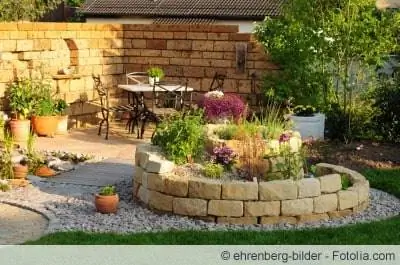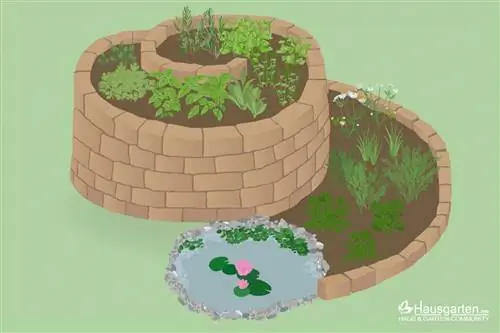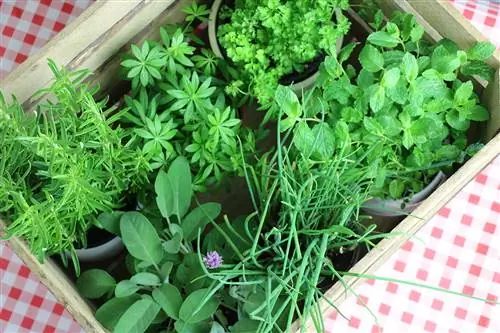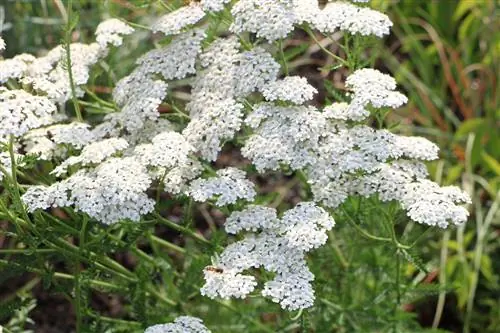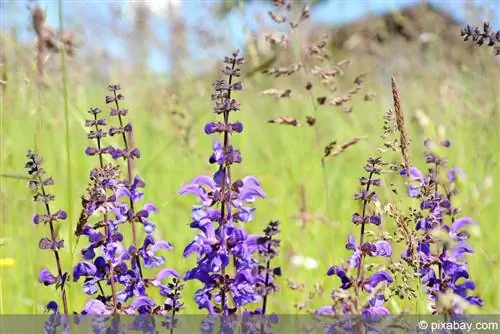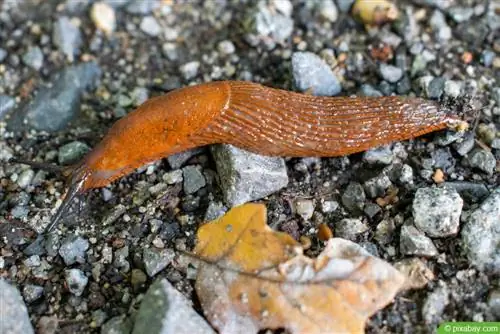- Author admin [email protected].
- Public 2023-12-17 03:39.
- Last modified 2025-01-24 12:45.
A herb auger is particularly ideal for small gardens where there is not enough space for a larger herb bed. In this spiral-shaped herb bed, various climate zones are simulated in a clear area, so that many different culinary herbs can find perfect conditions, even if they have different location requirements. As a special eye-catcher, a small pond can be created at the foot of the herb snail. A small biotope is created using a herb snail, which, with good planning, becomes a real gem in the garden.
Preparation
In order to create a herb snail on your own, good preparation is required. First you have to decide how big the herb snail should be, which herbs should grow in it and which stones are suitable for the border. In order to always have an overview of the structure, we recommend making a sketch. After setting up the herb snail, wait for the first rain so that the soil can settle well; you may need to add some soil to it. The following procedure has proven itself when preparing a herb snail:
- First mark the floor plan of the facility
- Small pegs that are connected with a string are ideal for staking
- Alternatively, the outline can be drawn on the ground with sawdust
- Dig the ground beneath the site to a spade depth and fill it with gravel or gravel
- Gravel serves as drainage, increases permeability and prevents waterlogging
- Plan herb snail with a diameter of 1-1, 50 m
- Ideal distance between the side walls is 20-30 cm
- Coarse natural stones are ideal for the herb snail
- Clinker bricks and old bricks are also possible
Tip:
The gravel or gravel can be quite coarse in nature; it not only serves as drainage, but also as a stable foundation for the wall.
Selection of location
When looking for a suitable location for the herb snail, the direction plays an important role. Most herbs love full sun conditions with a long period of sunshine. If the chosen location is near a terrace or a seat, then the gardener can enjoy the wonderful herbal scents in summer:
- A sunny location in the garden is ideal
- Shady and hidden places under trees are not suitable
- Create the opening of the herb snail towards the south
- Prefer places protected from the wind next to walls and buildings
Spiral shape
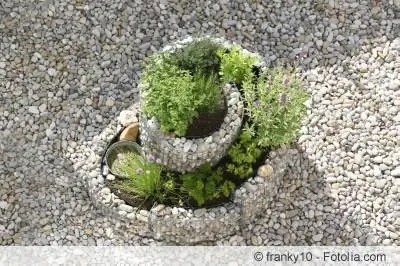
A herb snail is a practical herb bed in the garden, which also has a beautiful visual effect. This special herb bed is not created in the traditional rectangular shape, but in a spiral shape. In a herb spiral, herbs with different requirements in terms of sun intensity and location can be easily planted in a common bed. Normally, the stone wall of a herb snail is built using the dry construction method without added mortar. Skilled craftsmen can also build a solid wall bonded with mortar. After the exterior construction has been completed, the herb snail must be filled with gravel, humus and finally with nutrient-rich herb soil:
- Spiral shape ensures different types of sunlight
- Spiral can be piled up to 1.5 m, so plan enough space at the top
- The higher the herbs sit in the spiral, the more sun they get
- Plant shade herbs at the bottom of the spiral
- Build a dry wall in a spiral shape to give the herb snail its final shape
- Layer natural stones overlapping in the desired spiral shape
- Continuously stack the stones higher inside than on the outside edge
Tip:
Adding compost creates optimal growth conditions in the herb snail in the early stages.
Climate zones
A herb snail is usually divided into four different climate zones in which various herbs can grow. These four zones simulate different site conditions so that the herbs feel comfortable and grow splendidly. If the wall was laid as drywall, robust herbs will quickly settle in the joints. In addition, beneficial insects and lizards use the space between the gaps in the wall, as the stones can store solar energy for a long time and provide protection from predators. If the herbs are accommodated in the various climate zones according to their requirements, then they require little care. The following aspects must be taken into account in the different climate zones:
- First and uppermost zone is consistently sunny and very dry, is called Mediterranean zone
- In the Mediterranean zone, mix soil with a lot of sand and a little lime
- Second zone is the normal zone, also rather dry, but a little shady
- In the normal zone, mix the soil with not quite as much sand
- Second zone needs more humus
- In the third zone, the wet zone, wetter conditions prevail, especially in the substrate
- Add lots of compost soil
- Fourth zone is the water zone when constructing a mini pond
- Water generously after setting up, but only in dry weather
- Avoid waterlogging in the Mediterranean zone
- Prune growing herbs regularly
Selection of herbs
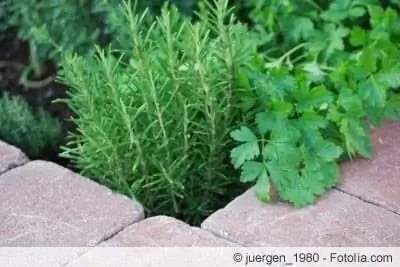
Not every plant is suitable for planting in a herb snail; herbs that grow extremely large and develop very long roots are not suitable at all. These include, among others, comfrey, lovage and peppermint. In addition, non-winter-hardy herbs, such as rosemary, should be planted in pots so that they can be dug up again before the first frost and overwintered in living spaces. The desired herbs should ideally be planted in the preferred direction so that they can thrive excellently. Mediterranean herbs in particular feel comfortable in the south and in full sun, while herbs that prefer the shade thrive on the northern side. The following criteria should be taken into account when selecting herbs:
- Top zone with dry and nutrient-poor soil quality: Ideal for popular Mediterranean herbs such as lavender, marjoram, rosemary, sage, thyme and hyssop
- Normal zone with dry but rather nutrient-rich soil: perfect for basil, oregano, lemon balm and coriander
- Moist zone with fresh and nutrient-rich garden soil: ideal for chervil, parsley and chives
- Water zone: Ideal environment for watercress, watermint and peppermint, as they have enough space to spread out
- Acquire pre-grown herbs from specialist retailers for quick development
- Alternatively prefer herbs from seeds
- Keep enough distance between the herbs
- Spring is ideal for planting for the first time
- Delineate boundaries between the zones, shapely stones are well suited for this
- Only start adding fertilizer in the second year
Create a pond
A small pond is the crowning glory of the herb snail and perfectly rounds off the biodiversity of the climate zones. This water zone is located in the outgoing area of the herb snail and should face directly south. A small garden pond not only provides water-loving herbs with enough moisture, but also many useful garden creatures, such as birds and lizards:
- Either use construction buckets or lay out pond liner
- Pile a layer of sand and gravel over the foil
- Hide the edge of the pot or pond liner under decorative stones
- Hemp rope serves as a wick to supply the wet zone above with enough water
- Make sure there are harmonious transitions between the wet zone and the water zone
Conclusion
A herb snail is an excellent idea, especially for amateur cooks, so that they always have fresh herbs at hand for cooking. The most important culinary herbs can be planted in this spiral-shaped herb bed in a small space and harvested if necessary. With good planning, the herb snail can be set up quickly and planted with pre-grown herbs from specialist retailers. Since the herb spiral simulates various location conditions, Mediterranean herbs that prefer full sun and warm places and cannot cope with cool and shady locations also thrive here. The spiral-shaped herb bed can be designed as desired and embellished with decorative elements; there are no limits to your imagination. A beautiful end to the herb snail is a miniature garden pond where herbs that love moisture thrive. If the herb snail is set up next to a seat or a terrace, it not only delights the palate while cooking, but also the sense of smell with fragrant herbal scents and the eye with an attractive appearance.

